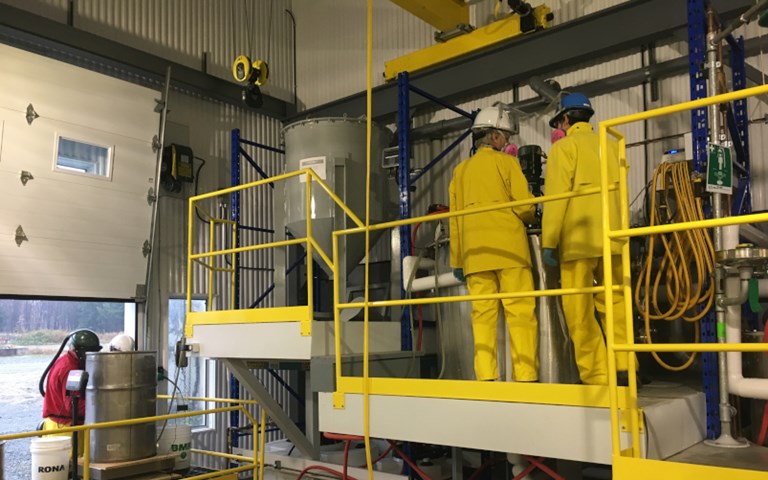Funding from Blue Lagoon will be used to complete testing on Mag One's production process and begin work on a demonstration plant. Courtesy of Mag One.
On Jan. 6, 2020 Mag One Products signed an agreement with mineral exploration company Blue Lagoon Resources for up to $5.25 million worth of shares and 70 per cent interest of Mag One’s subsidiary, Mag One Operations. The company is currently testing a process for the production of pure magnesium from mine tailings.
Mag One Operations is trialing its process at its Quebec operations in Asbestos and Thetford Mines. Funding from Blue Lagoon will be used to complete pilot testing of its magnesium oxide production process and to start engineering a demonstration plant which, according to Mag One’s third quarter 2019 management discussion and analysis report, will be constructed in 2021. Once built, production at the plant is estimated at 30,000 tonnes of magnesium oxide and 33,000 tonnes of amorphous silica per year.
The final stage of development will be the design and construction of a 5,000 tonne per year primary magnesium module, with additional modules being financed from operating revenue until production reaches one million tonnes per year, according to the MD&A. Mag One says it needs to “complete pilot plant efforts to garner offtake agreements and begin the engineering of this facility.”
“We’re thrilled that we caught Blue Lagoon’s interest,” Gillian Holcroft, CEO and president of Mag One, told CIM Magazine in an interview. “They came to Quebec and visited our pilot facilities, they walked on the tailings and the fact that they’re willing to invest up to $5.25 million over the next two years to advance our project is a great testament to the company.” Blue Lagoon Resources will also have the option to purchase an additional 50 per cent interest in the company by making a further cash investment of $1.5 million within 18 months of the deal’s closing date.
Mag One Operations is currently testing a process to produce magnesium from mine tailings at its Quebec operations in Asbestos and Thetford Mines. Funding from Blue Lagoon will be used to complete pilot testing the project and to start engineering a demonstration plant. Once built, production at the plant is estimated at 30,000 tonnes of magnesium oxide and 33,000 tonnes of amorphous silica per year.
Pilot testing of the process has produced both high purity magnesium salt and high purity amorphous silica using a very strong acid. The process involves neutralizing the magnesium salt for impurities such as iron and nickel, and decomposing it to create magnesium oxide. According to Holcroft, since the iron and nickel byproducts can be sold themselves and any gases produced can be used to regenerate the acid, it is "a cost-effective, stand-alone process.”
Related: UBC professor Greg Dipple aims to prove that tailings could be a mine’s secret weapon for reducing its carbon footprint
Other ways to produce magnesium from tailings are quite labour and energy-intensive. China is the leading producer of magnesium worldwide and relies on the Pidgeon Process, which relies heavily on coal and silicon to produce a magnesium “crown,” where magnesium ore crowns to the surface of the thermal solution and is then manually extracted. Other methods of magnesium production from tailings include hydrometallurgy and electrolysis, which were both used at the former Noranda Magnola plant in Asbestos, Quebec.
Dr. Douglas Zuliani, technology advisor at Mag One and president and founder of Tech Magnesium, is behind Mag One’s magnesium metal production design. Formerly VP manufacturing and technology at Timminco, Zuliani saw the Pidgeon Process firsthand and came up with an idea of how to make a thermal production of magnesium more efficient. The result is a process without coal, silicon or electrolysis, and which produces saleable byproducts.
According to Mag One, the carbon footprint of its magnesium production process is significantly lower than alternative methods. For every tonne of magnesium metal produced, the Pidgeon Process produces about 26 tonnes of CO2 and electrolysis about 18 tonnes of CO2. Mag One’sprocess only produces about five tonnes of CO2 for every tonne of magnesium metal. “The neat thing about our project is that we take tailings and don’t generate waste,” explains Holcroft. “It’s a zero-waste project.”



